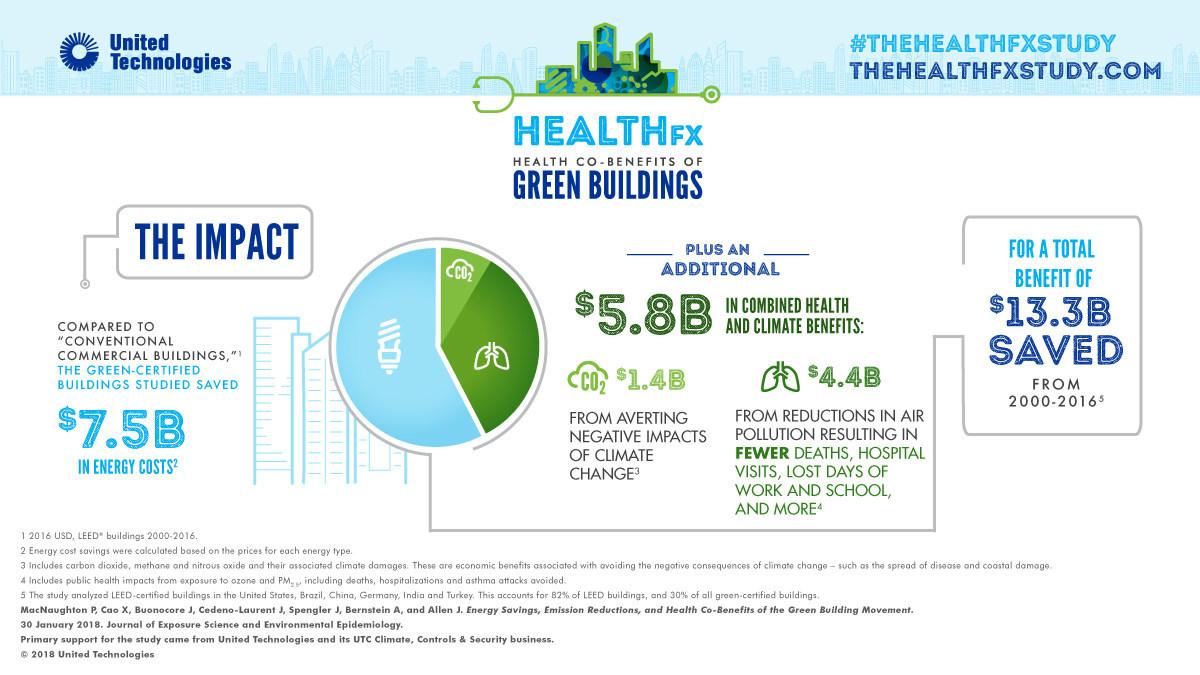by Brianna Crandall — February 21, 2018 — Did you know buildings can deliver billions of dollars’ worth of public health benefits, including fewer hospitalizations and reduced climate impacts? A new study says that’s the case — if they’re energy-efficient green buildings.
Experts at Harvard University examined a subset of green-certified buildings over a 16-year period in six countries: the US, China, India, Brazil, Germany and Turkey. Known as HEALTHfx, the study found nearly $6 billion in combined health and climate benefits.
- In some countries, health and climate benefits far exceeded — in dollar amounts — energy savings.
- Globally, the studied green-certified projects saved billions of dollars in energy costs.
- Globally, 33,000 kilotons of CO2 were avoided, equivalent to 7.1 million fewer passenger cars on the road for one year.
This equates to:
- $4.4 billion in estimated public health benefits from fewer:
- Deaths
- Hospital visits
- Asthma attacks
- Respiratory symptoms
- Lost days of work
- Lost days of school
- $1.4 billion in estimated climate benefits from reductions in:
- Carbon dioxide (CO2)
- Methane (CH4)
- Nitrous oxide (N2O)
This is all in addition to $7.5 billion in energy savings from the green-certified buildings studied. Considering that the buildings studied included only LEED-certified buildings, which are approximately one-third of the global green building stock, total benefits worldwide would be even greater, points out UTC.
In fact, HEALTHfx found that on average, for every dollar saved on energy costs by green buildings, another $0.77 was saved in health and climate benefits. In China and India, the effects were even more dramatic, with approximately $10 in health and climate benefits for every dollar in energy savings.
Dr. Joseph Allen, assistant professor of Exposure Assessment Science and director of the Healthy Buildings program at the Harvard T.H. Chan School of Public Health, led the research. Dr. Allen stated:
The energy savings of green buildings come with a massive public health benefit through associated reductions in air pollutants emitted. We developed the Co-benefits of the Built Environment (CoBE) calculator in this study as a tool that people can use for understanding the health impacts of building portfolios, investments and building strategies. The decisions we make today with regard to buildings will determine our current and future health.
John Mandyck, chief sustainability officer, United Technologies, remarked:
Green buildings are designed to save energy and water while promoting healthy indoor environments. Now we know the reduced environmental impact of building green is amplified with quantifiable benefits to public health and climate resilience. With this new human context, we can accelerate the green building movement globally from this groundbreaking research.
This latest study builds on the team’s 2015 COGfx Study — COGfx is shorthand for your brain’s cognitive function — which showed 101% improvement in cognitive function test scores when workers spent time in an office with high ventilation, low CO2 and low volatile organic compounds, compared to when they were in a “conventional” office environment. In 2016, the team expanded the experiment and found that, in green-certified buildings, employees scored 26% higher on cognitive function tests, reported 30% fewer sick building symptoms and 6% higher sleep quality scores. With HEALTHfx, it’s been shown that better health is found not just inside better buildings — but outside those buildings as well.
The peer-reviewed paper, “Energy Savings, Emission Reductions, and Health Co-Benefits of the Green Building Movement,” was published by the Journal of Exposure Science and Environmental Epidemiology. The full report is available from the Journal’s Web site or UTC’s HEALTHfx site. Primary support for the study came from high-tech systems and services provider United Technologies and its UTC Climate, Controls and Security business, which provides HVAC/R systems, building controls and automation, and fire and security systems.





